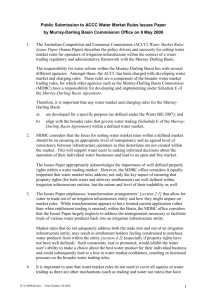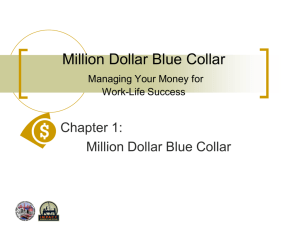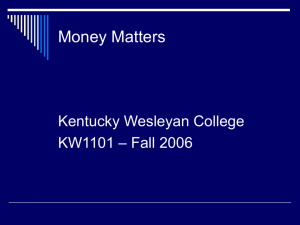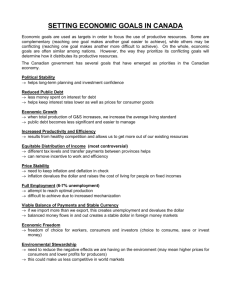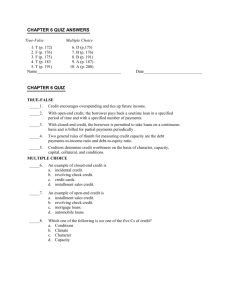Million Dollar Blue Collar
advertisement
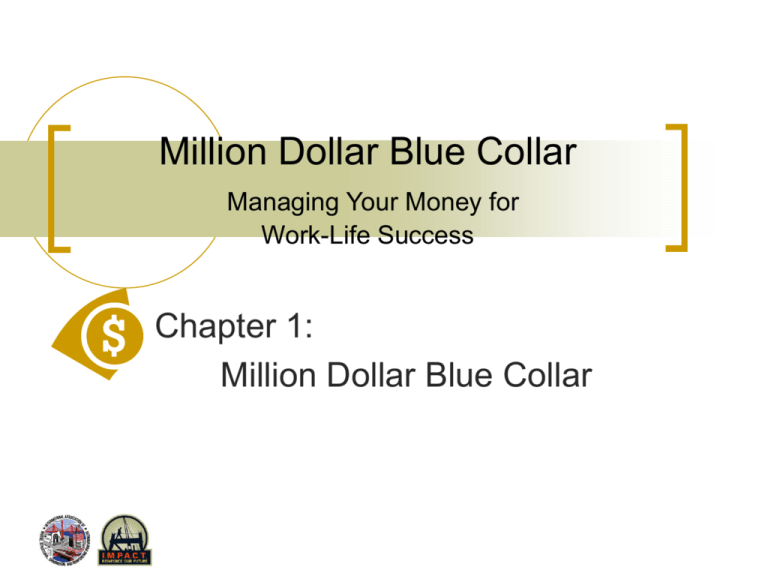
Million Dollar Blue Collar Managing Your Money for Work-Life Success Chapter 1: Million Dollar Blue Collar Introduction This course is designed to help you: Maximize your earnings for stability, success, and fun; Build a financial foundation of accomplishment and self-esteem; Accelerate your journey to the life you want and deserve. MDBC: Chapter 1 Introduction (continued) Every apprentice and journeyman can learn to create financial security. Learning basic financial management skills is as important as learning the “three Rs.” It’s never too late to learn. MDBC: Chapter 1 Topics The following topics will be covered: The Construction Challenge Managing Your Earnings for Work-Life Success Strategic Buying and Selling Credit = Debit Taxes, Saving, and Wealth MDBC: Chapter 1 Topics (continued) Protecting your Ass, Assets, and Future For Spouses Only Very Personal Finances Financial Troubles Union Resources, Union Benefits MDBC: Chapter 1 Million Dollar Blue Collar How you handle and manage money will determine your work and life success more than how much you make, every time. Many rich people, star athletes, politicians and movie stars have filed for bankruptcy. Good financial habits and decisions don’t come automatically from a high income— they come from knowledge, discipline, and plain old common sense. MDBC: Chapter 1 Questions? MDBC: Chapter 1 Million Dollar Blue Collar Managing your Money for Work-Life Success Chapter 2: Construction Challenge Apprentice Success and the 10-12 Challenge Managing money can be tough for construction professionals because of lopsided hours and compensation. You need to create a financial action plan on the 10-12 challenge: work 10 months, budget for 12. People often live large on paychecks when they’re busy, and end up in the hole in lean months. MDBC: Chapter 1 Apprentice Success and the 10-12 Challenge (continued) Common obstacles include: “Cigar box” budgeting: put money in, take money out, and what’s left over is what’s available “It’s burning a hole in my pocket”: spending every penny you’ve got MDBC: Chapter 1 Journeyman Success and the Construction Cycle Roughly every seven to ten years, the construction industry goes through a downturn. Construction gets hit by recessions, interest rate changes, and more. Downturns are predictable. Tip-offs include hearing “recession” or “new housing starts are down” in news reports. MDBC: Chapter 1 Emergency Funds Always have money saved for emergencies. Most financial planners recommend having six months in reserve. A few thousand bucks saved can make the difference between staying afloat or going under. MDBC: Chapter 1 Planning for Downtime General construction runs hard from roughly March through November. Many of you receive some vacation pay— Money that’s deposited on your behalf for every hour you work, but it won’t cover your bills for 2–3 months. Vacation Pay can help cover seasonal income gap. Don’t “pre-spend” it as take-home pay. MDBC: Chapter 1 Budgeting for 10-12 Do you know how much you can afford to spend every day, week, month, and year? In order to create a 10-12 financial budget, do a budget analysis first to give you a starting point. MDBC: Chapter 1 The 10-12 Financial Formula Calculate one year’s take-home pay Average 1,500 hours x hourly wage – taxes = $_______ Divide this number by 12 $_______ / 12 = your monthly income Multiply your monthly income by 2 $_______ x 2 = $_______ = the reserve amount you will need every year for two months of living expenses while you’re out of work MDBC: Chapter 1 The 10-12 Financial Formula (continued) Take the reserve amount and divide it by 10 $______ / 10 = $_______ This is how much you need to save each month you work to meet the 10-12 challenge. Monthly savings $______ x 10 = $________ two-month reserve MDBC: Chapter 1 Basic Budget Calculation and Worksheet Create a worksheet based on the following lists: Must spend: things that must be paid for every month, such as rent, food, insurance, and child support Plan to spend: stuff you need but not necessary right now, such as a new roof, new tires, etc… Wish list: stuff you want, such as a new boat, shotgun, HDTV, or vacation next year MDBC: Chapter 1 Digging a Hole by Playing Pretend Roughly 20% of construction workers end up in financial trouble. Ignoring money is like walking onto a job site blindfolded—if you can’t see where you are, you can’t see where you’re going. MDBC: Chapter 1 Increasing Construction Income The following are simple ways to boost your income on the job: Take all the overtime you can get. Take whatever work is offered. Don’t call in sick. Get supplemental upgrade training. Make sure your supervisor and boss know who you are. Shoot for certified or supervisory positions that create premium pay. Stay healthy. Work hard and don’t make excuses. MDBC: Chapter 1 Good Money and a Great Opportunity Here’s how union construction earnings compare to the rest of the country: In 2006 half the population in the US made less than $48,200 a year. 47 million people do not have any health insurance. 36.5 million people live below the poverty line (roughly $20,000 or less for a family of four). Less than 50% of US workers have any retirement plan at all. MDBC: Chapter 1 Online Resources CNNMoney.com—Making a Budget http://cgi.money.cnn.com/tools/budget1 01/budget_101.jsp Kiplinger.com—A Budget for Today and Tomorrow http://www.kiplinger.com/tools/budget/ MDBC: Chapter 1 Questions? MDBC: Chapter 1 Million Dollar Blue Collar Managing Your Money for Work-Life Success Chapter 3: Managing Your Earnings for Work-Life Success Setting Work-Life Financial Goals Research shows that those who write down their goals are more likely to attain them. Without goals, people have nothing to work toward. Goals help you guide your life instead of letting life guide you. MDBC: Chapter 1 Getting Organized vs. Piles of Crap Designate a place in your home where you’ll handle your finances. Get the following office supplies: file holder with at least three slots for “bills to pay,” “bills paid,” and “stuff to file” self-sealing envelopes stamps MDBC: Chapter 1 Getting Organized vs. Piles of Crap (continued) More office supplies: a filing cabinet a fireproof box file folders a shredder a wall calendar a waste basket Once a month file your important stuff. MDBC: Chapter 1 Getting Organized vs. Piles of Crap (continued) Create a folder for each of the following: union membership and benefits credit card insurance automotive payroll stubs and W-2s (T-4s for Canadians) taxes warranties and instructions will and other personal documents credit files (car payments, utilities, phone, etc.) kids’ records, artwork, and school MDBC: Chapter 1 Hiring Professionals Some financial tasks are best left to the pros. Below is a list of professionals to consider hiring: insurance agents lawyers realtors and mortgage brokers bookkeepers/accountants tax preparers home improvement contractors MDBC: Chapter 1 Hiring Professionals (continued) Follow these guidelines when you hire a professional: Don’t just hire your friends. Check references. Be very clear and detailed about your expectations, contractual terms, and payment terms. Don’t hesitate to call people out on performance. Offer to provide a good reference. Don’t hesitate to fire someone. MDBC: Chapter 1 Basic Banking Banking is a necessity in the modern world. Without it, you’re throwing money away. You need both a checking account and a savings account. Cashing a check feels great, but it’s hard to hang onto the cash. MDBC: Chapter 1 Checking Accounts Checking accounts save time and money. Most banks charge a flat monthly fee of around $10 or less if you keep a minimum amount in the account. Without a bank account, you’ll pay hundreds of dollars in cash checking fees and buying money orders to pay your bills. MDBC: Chapter 1 Savings Accounts Open a savings account, so you’ll have a place to put your rainy-day money. This is where you would put your 1012 buffer money. Savings accounts pay interest on your money. MDBC: Chapter 1 Opening Your Accounts Don’t be intimidated by banks. Just follow a few easy steps, and you’ll have an account open in no time. Visit a bank or credit union and bring your ID and Social Security card with you. Tell them you want an ATM or debit card linked to your checking account. MDBC: Chapter 1 Opening Your Accounts (continued) It’s a good idea to open your account with as much money as you can. Banks look at opening deposits when you apply for a loan. Also, a large opening deposit can qualify you for lower fees and other advantages. MDBC: Chapter 1 Online Banking Banking online is secure and convenient. It takes the guesswork out of balancing your checking account because you can check it 24 hours a day, 7 days a week. MDBC: Chapter 1 Online Banking (continued) It allows you to pay your bills online. It eliminates the need for envelopes, stamps, and late fees. You can schedule your bill payments. MDBC: Chapter 1 ATMs An ATM is a fast and easy way to get cash from your bank account. Use your own bank’s ATMs to avoid fees, which typically run from $1.50 up to $3.00. Keep your receipts to keep track of your transactions. Take out the least amount of cash you need. MDBC: Chapter 1 Direct Deposit Reasons to set up direct deposit include: It saves trips to the bank. It encourages people to have a relationship with a bank. It keeps people from cashing checks at bars, stores, and other places where unnecessary spending may occur. MDBC: Chapter 1 Little Things Add Up Identify the little things that take away from your finances. By eating breakfast at home, brown bagging your lunch, carpooling, and giving up smoking (or going down to half a pack), you’ll save between $4,000 and $5,000 a year. Saving a little bit of money every couple of days can add up over time. MDBC: Chapter 1 Online Resources About.com—Choosing a Bank http://banking.about.com/od/savings/a/ chooseabank.htm MDBC: Chapter 1 Questions? MDBC: Chapter 1 Million Dollar Blue Collar Managing Your Money for Work-Life Success Chapter 4: Strategic Buying and Selling Financing Purchases (or not) Be aware of “no payments until next year” purchases. Often the payments come due sooner than you realize. MDBC: Chapter 1 Impulse Buying vs. Planned Purchases Stores bet on shoppers to be impulse buyers. Planning and researching big purchases (anything over $250–$500) will pay off in the long run. Remember: After the thrill of an impulse purchase is gone, how much you paid for it will remain. MDBC: Chapter 1 Possession vs. Utilization Marketers are constantly trying to convince us we need more stuff. Before you purchase any major nonessential item, such as a boat, snowmobile, or RV, ask yourself how much you’ll actually use it over three years. All of these items require extra expenses, such as gas, insurance, and general maintenance costs. Consider renting these items when you have time to use them. It will be smarter and cheaper in the long run. MDBC: Chapter 1 Basic Negotiation Strategies for Buying and Selling Basic strategies include: Don’t be afraid to bargain. Don’t allow emotions to cloud your judgment. Pay cash at the point of sale. Have good price information. Always leave something on the table. MDBC: Chapter 1 Buying Decisions: Price vs. Value It’s important to pay attention to price, but pay more attention to value. Decide what items are worth top dollar to you and what items you could spend less on. Don’t buy things just for status. Think of things you can buy discounted or pre-owned for major savings. Result will maximize the value of every dollar you spend. MDBC: Chapter 1 Private Party and Internet Purchases Private party purchases are good options to get deep discounts on goods. Look at newspapers, PennySaver, want ads, and Craigslist.com—a community website where people buy and sell goods. Consider making purchases through the Internet in order to save on sales tax. MDBC: Chapter 1 Buying a Car Cons of buying a new car: New cars depreciate 10–20% off the sticker price the instant you drive them off the lot. Plus you’re likely to be sold things you don’t need or want. MDBC: Chapter 1 Buying a Car (continued) Tips for buying a used car: Pre-qualify for your loan. Consider lease turn backs. Use an auto broker. Go to Kelley Blue Book online (KBB.com). Compare pricing information. Check out the car’s title and condition at Carfax.com. MDBC: Chapter 1 Saving on Car Insurance Good car insurance can cost between $500 and $1,000 per year. Check into the following discounts: good driver discount combining homeowners insurance with auto to get 20% off defensive driving school (5–10% off) multiple vehicle discount good student discount high deductible discount MDBC: Chapter 1 Saving on Car Rental Insurance To avoid expensive car rental insurance: Confirm that your primary auto insurance is a “drive anything” plan that covers any vehicle you drive, including rentals. Check with your credit company to see if it includes rental car insurance coverage. MDBC: Chapter 1 Buying a Home A home is a good investment. There are significant tax savings. Don’t saddle yourself with an excessive house payment. Your construction skills are a big plus if you buy a fixer-upper. MDBC: Chapter 1 Home Mortgages Do your homework before you sign up for a mortgage. Here are a few basic mortgage definitions: Fixed-rate: The interest rate stays the same for the length of the mortgage. Adjustable-rate: The interest rate will change over the life of the mortgage. Interest-only: Monthly payments are lower because you’re only paying the interest, not the principal. MDBC: Chapter 1 Online Resources Craigslist.com http://www.craigslist.com Kelley Blue Book http://www.kbb.com US Department of Housing and Urban Development (HUD) http://www.hud.gov/offices/hsg/sfh/buyi ng/glossary.cfm MDBC: Chapter 1 Questions? MDBC: Chapter 1 Million Dollar Blue Collar Managing Your Money for Work-Life Success Chapter 5: Credit = Debt Credit Card Basics Credit card companies make it easier for you to spend more than you can afford. Most people don’t think about how much they’ve already charged this month when they reach for their credit card. MDBC: Chapter 1 Credit Cards: By the Numbers There are approximately 650 million credit cards in circulation in the US. Americans spend more than $1.5 trillion per year using credit cards. The banking industry makes more than $30 billion dollars per year from the interest it charges people. The average American’s credit card debt is $8,562. MDBC: Chapter 1 Picking a Card: Interest Rates and Rewards If you carry a balance, pick a card with the lowest interest rate. You can perform a search on the Internet to compare interest rates from credit companies. Many credit cards give out airline miles or other redeemable rewards. Choose a reward program that you’ll use. If you’re a member of a credit union, check with it first. It may have the best option for you. MDBC: Chapter 1 Debit Cards vs. Credit Cards Debit cards are a good way to avoid credit card bills. Debit cards take the money right out of your checking account. Keep track of your debits by entering them in your checkbook. MDBC: Chapter 1 Minimum Payments: 30 Years in the Hole The minimum payment squeezes more money out of you. Example: If you owe $10,000 with a 16–18% interest rate and make the minimum payment (about 2.5% of the balance or $250), it will take you 382 payments (31.8 years) to pay it off. You’ll pay more than $14,000 in interest. MDBC: Chapter 1 Paying Down Your Debt Paying the minimum is not an effective way to get rid of credit card debt. You need to attack debt aggressively by increasing payments. Tip: Always pay down the card with the highest interest rate first. Be aware that credit card companies can increase your interest rate if you’re late paying your bills. MDBC: Chapter 1 Credit Reports and Ratings A credit report is a detailed breakdown of your credit history. It includes payment history on loans and credit cards, bankruptcies, and unpaid judgments. Your credit rating impacts your ability to get the best credit terms on everything you buy, especially bigticket items such as cars and houses. If your credit rating is poor, you’ll pay higher interest rates or you may not be able to get credit at all. MDBC: Chapter 1 How to Maintain a Decent Credit Rating Tips to maintain a decent credit rating: Pay your bills on time. Keep credit card balances as low as possible. Check your credit report for accuracy every year. Pay off debt rather than moving it around. Build a positive credit history. Don’t open multiple accounts too quickly. Don’t open new credit card accounts if you don’t need them. Don’t close an account thinking it’ll be removed from your record. MDBC: Chapter 1 Credit Card Consolidation If your credit card debt is too large, consider consolidating your payments. It will not improve your credit score, but you can often arrange better payment terms and lower payments. Contact your bank or credit union to learn more about debt consolidation. MDBC: Chapter 1 Major Credit Card Debt Consider these common sense steps for managing major credit card debt: Stop using your cards. Keep making the minimum payment on time. Lower your interest rate. Pay off your debt by making larger payments each month. MDBC: Chapter 1 Payday Loans The payday loan industry is a $40 billion enterprise. Often the interest rates it charges people are criminal. Payday loans require you to pay a fixed amount every week or two weeks (on payday) at interest rates that can exceed 500%. Avoid payday loans at all costs. MDBC: Chapter 1 Online Resources Bankrate.com http://www.bankrate.com The Motley Fool.com—Calculators http://www.fool.com/calcs/calculators.htm Credit Reports Equifax.com—Credit Report http://www.equifax.com/ Experian—Credit Report http://www.experian.com/ TransUnion—Credit Report http://www.transunion.com/ MDBC: Chapter 1 Online Resources (continued) Bankrate.com—How Credit Scores Work http://www.bankrate.com/brm/news/cre dit-scoring/20031104a1.asp The Motley Fool.com—Should I Consolidate My Credit Cards? http://partners.leadfusion.com/tools/mo tleyfool/card08/tool.fcs MDBC: Chapter 1 Questions? MDBC: Chapter 1 Million Dollar Blue Collar Managing Your Money for Work-Life Success Chapter 6: Taxes, Saving,and Wealth Taxes: Who’s Your Daddy? Uncle Sam Taxes make a significant impact on your earnings. You work from Jan. 1st to roughly April 30th every year just to pay your taxes. You work the first week and a half of every month to pay your taxes. You work the first two and a half hours on the job each day for Uncle Sam. MDBC: Chapter 1 Tips for Minimizing Your Taxes Buy a house and take the mortgage deduction (US only). Make sure you have enough withheld from your paycheck so you don’t owe anything extra come April 15th. Deduct your charitable donations. MDBC: Chapter 1 (Lame) Excuses for Failing to Save Don’t fall for these excuses when it comes to saving: I don’t make enough money. Remember: Saving is a behavior not an amount. I’ll start next week. I earned it. I deserve to spend it. I’m making an investment (when buying a “want” instead of a “need”). Other people I know don’t save. It’s too late for me to start. MDBC: Chapter 1 Wealth Consider the following ways to increase the return on your money: Money market funds usually pay higher interest rates. Check your credit union’s rates for higher interest rates on accounts. Compare bank rates on Bankrate.com. Ask your bank whether it has certificates of deposit (CDs). MDBC: Chapter 1 Wealth (continued) Once you’ve committed to a savings plan, you’ll see your investment increase due to compound interest. Compound interest is the concept of adding accumulated interest back to the principal, so that interest is earned on interest from that moment on. For example: If you put $1,000 in a savings account earning 5% per year and you didn’t touch it for 5 years, you would earn $276.28…just for saving! MDBC: Chapter 1 Investing Your Money If you’re in a position to invest your money, then consult professionals who can help you move your savings to the next level. MDBC: Chapter 1 Online Resources Bankrate.com—Checking & Savings Rates http://www.bankrate.com/gookeyword/rate/chk_sav _home.asp The Motley Fool—Investing Basics http://www.fool.com/investing/basics/index.aspx Kiplinger.com—Tax Tips http://www.kiplinger.com/columns/taxtips/ Bankrate.com—Compound Interest Calculator http://www.bankrate.com/brm/news/sav/2006savmg /savings-calc.asp MDBC: Chapter 1 Questions? MDBC: Chapter 1 Million Dollar Blue Collar Managing Your Money for Work-Life Success Chapter 7: Protecting Your Ass, Assets, and Future Protecting Yourself and Your Family Life and work responsibility is not just about managing your income and resources. It’s important to plan for the unexpected. MDBC: Chapter 1 Disability Insurance: Plugging the Income Gaps It’s not uncommon to have an extended period of being unable to work due to an injury or illness, especially in the trades. Disability insurance provides income when you’re too sick or injured to work. It’s a safety net that ensures you won’t be caught without an income if you become injured. Depending on the policy, it takes 30, 60, or 90 days before you’ll begin receiving payments. MDBC: Chapter 1 Car Insurance: A Case Study Without car insurance, you could be in danger of being totally financially wiped out if you’re in an accident. Dealing with an injury and a totaled car can cost you upwards of $10,000. Good insurance may not be cheap, but it’s a bargain compared to not having enough coverage. MDBC: Chapter 1 Early Exit: Life Insurance Life insurance can protect your family from financial hardship should you die unexpectedly. Consider purchasing a “term life” policy. Term life polices charge you a relatively low premium for $100,000–$300,000 in coverage. The coverage is limited for a “term,” e.g., as long as you continue to pay the monthly or annual premium. If you die within the term, the policy pays your survivors. MDBC: Chapter 1 A Will to Live, a Will to Die A will can protect your family from having to sort out and deal with financial issues. If you have a spouse and/or children, you need a will. You can get a basic will kit on the Web. MDBC: Chapter 1 Medical Power-of-Attorney A medical power-of-attorney is a legal document that gives someone the legal power to make medical decisions on your behalf in case you’re unable to make them for yourself. This is a big responsibility, and you should have an honest and serious conversation with the person you choose who will act on your behalf. MDBC: Chapter 1 On (Not) Being a Co-Signer A co-signer is someone with good credit who essentially promises to make the payments in case the borrower defaults on the loan. Being a co-signer means you assume the credit and financial risk for someone else. Nationwide, at least 10% of all co-signed loans go into default. MDBC: Chapter 1 On (Not) Being a Co-Signer (continued) If you do become a co-signer, follow these tips: Make sure your name is on the title of the asset. Make sure you have a set of keys or access to the asset in case you have to take possession. If your co-signee has stopped making payments, contact the lender immediately. The lender may give you a grace period or modify the payment term. Make sure the asset is fully insured. If the cosignee stopped paying the loan, he or she probably stopped paying insurance as well. MDBC: Chapter 1 Protecting Your ID Each year, 10 million people are hit with some form of ID theft or fraud. The highest rates of ID theft and fraud are perpetrated against 23–35 year olds. MDBC: Chapter 1 Protecting Your ID (continued) Follow these tips to protect yourself against ID theft: Create “strong” passwords for your online accounts. Use a combination of numbers and upper- and lower-case letters. Don’t use birthdays, kid’s names, pets’ names, etc. Don’t carry your Social Security card or number in your wallet. Don’t write down passwords and keep them near your computer. Never give out your passwords to anyone. MDBC: Chapter 1 Protecting Your ID (continued) More tips to protect yourself against ID theft: Shred all credit card offers that come in the mail. Don’t give out personal information to anyone who calls you on the phone or on any unsecured website. Don’t respond to unsolicited bank emails telling you there’s a problem with your account. Don’t give people, stores, or other organizations information they don’t need. MDBC: Chapter 1 Online Resources The Motley Fool—Insurance Center http://www.fool.com/insurancecenter/disability/disab ility.htm LawDepot.com—Automated Legal Forms http://www.lawdepot.com/contracts/groups/estate/ US Social Security—Identity Theft and Your Social Security Number http://www.ssa.gov/pubs/10064.html US FTC—Identity Theft Site http://www.ftc.gov/bcp/edu/microsites/idtheft/ MDBC: Chapter 1 Questions? MDBC: Chapter 1 Million Dollar Blue Collar Managing Your money for Work-Life Success Chapter 8: For Spouses Only Communication Communication can help minimize arguments about money. Communicating upfront about your financial game plan is very important. MDBC: Chapter 1 Questions to Ask Your Spouse Who’s going to handle paying the bills? Are we going to have joint or separate bank accounts? Are we going to keep household money in a separate account or combine it with our general funds? What is our agreement on spending and using credit cards? MDBC: Chapter 1 Questions to Ask Your Spouse (continued) How are we going to use ATMs? How much walking around cash do we need each week? What is our savings goal per month, and where does it fit in our priorities? Does it matter who makes more when we make decisions? When should we review these decisions if we want to change them? MDBC: Chapter 1 A Team Approach People have different strengths and risk tolerances that make managing money a team approach. Work together to assign financial responsibilities so they don’t all fall to one person. MDBC: Chapter 1 A Team Approach (continued) Examples include: paying monthly bills setting up wills and medical powers-ofattorney checking on union benefits and coverage setting up a household budget making and negotiating major purchases MDBC: Chapter 1 A Team Approach (continued) More examples include: selecting professionals (real estate, bank, insurance, etc.) figuring out college financing dealing with bill collectors, if applicable determining what to do with investments, inheritances, and such making sure you keep each other involved and informed MDBC: Chapter 1 Spouses Deserve the Big Picture Spouses should stay informed about the construction industry. Here are some ways to be involved: Read all information sent to your spouse from the union trust funds. Read all union newsletters and bulletins. MDBC: Chapter 1 Spouses Deserve the Big Picture (continued) More ways to be involved: Attend union meetings and events when appropriate. Visit the union website for news. Identify upgrade training and other opportunities available to your spouse during the slow season. MDBC: Chapter 1 Holding Down the Fort Here are a few tips for spouses who need to hold down the fort while their spouses are working out of town or lots of overtime: Before a heavy OT or out-of-town job starts, spend quality time together. Identify a support network you can join. MDBC: Chapter 1 Holding Down the Fort (continued) More tips to hold down the fort: Consider asking your employer to allow you to alter your hours for the duration of the project. Remember that flying solo is only temporary. Hang in there! MDBC: Chapter 1 Leveraging Spouse Benefits Well over 50% of spouses work outside the home. Often their employers will offer overlapping, duplicate, or complementary benefits. It’s a good idea to review benefits annually as a way to increase your savings. MDBC: Chapter 1 Leveraging Spouse Benefits (continued) Here are a few points to consider: Some companies allow unused health insurance benefits to be converted to extra pay. Many employers offer Health Savings Accounts that can boost tax advantages. Check to see whether your spouse can deduct pre-tax dollars to pay for child care and/or medical expenses. Look into enrolling in a retirement or matching 401(k) plan to maximize saving opportunities. MDBC: Chapter 1 Spousal Support (the Good Kind) Never underestimate the impact of your support and belief in your spouse. Constant complaining can discourage your partner by diminishing his or her self-esteem and self-image. You are your spouse’s best cheerleader. MDBC: Chapter 1 Online Resources ADD YOUR UNION’S WEBSITE ADDRESS HERE. MDBC: Chapter 1 Questions? MDBC: Chapter 1 Million Dollar Blue Collar Managing Your money for Work-Life Success Chapter 9: Very Personal Finances Doing for Others The US is the largest giving nation in the world. Americans contribute more than $100 billion a year nationwide and around the world. Never forget that there are people in the world less fortunate than you are. If you’re capable of giving to others or doing for others, why not do it? Consider donating some money or time to a charity you believe is valuable. MDBC: Chapter 1 Family and Money Here are a few things to keep in mind: Family members sometimes have widely varying and often unrealistic expectations when it comes to borrowing, lending, and payback schedules. Family members may judge, harbor resentment against, and have unrealistic expectations about those doing better or worse than they are. When estates change hands, families can be stressed over disbursements if a strong executor is not in control. MDBC: Chapter 1 Lending and Borrowing Money Lending and/or borrowing money between friends and family can be tricky and difficult. Most people will tell you not to do it. MDBC: Chapter 1 Lending and Borrowing Money (continued) If you find yourself in a position where you are considering lending or borrowing funds, consider using a company, such as Virgin Money, to act as a go-between. For a fee, these companies collect and disburse payments. This arrangement makes transactions more professional. MDBC: Chapter 1 Divorce and Finance When faced with a divorce, keep the following in mind: Keep a level head to stay focused on the issues that need to be resolved, not your emotions. Try to compress the legal and financial issues into the shortest possible timeframe. Try to control your legal costs by not dragging out the divorce. Consider using a mediator as an economical and practical alternative to a divorce lawyer. MDBC: Chapter 1 Obligations: Child Support Keep your child support payments current. Missing enough payments may result in having your wages garnished. Child support is about your children, not your ex. You’ll have self-worth, pride in parenting, and the love and loyalty of your kids. MDBC: Chapter 1 Online Resources Networkforgood.org http://www.networkforgood.org/donate/ United Way http://www.liveunited.org/ VirginMoney http://www.virginmoneyus.com/ DivorceCenter http://www.divorcenter.org/ MDBC: Chapter 1 Questions? MDBC: Chapter 1 Million Dollar Blue Collar Managing Your Money for Work-Life Success Chapter 10: Financial Troubles Are You in Deep? Many people put off dealing with their financial problems until they’re in over their heads. An estimated 10–20% of union construction workers have their wages garnished to pay off their taxes, obligations, or debts. MDBC: Chapter 1 Getting Help Seek help to turn your financial situation around. Look into credit counseling. When looking for a credit counseling service, make sure its profile includes: a good record with the Better Business Bureau a long-term track record education resources and certified counselors a low-cost, reasonable fee structure MDBC: Chapter 1 Debt Management If you find yourself with no possible way to repay your debt, tell your creditors where you stand. Creditors may renegotiate your debt. A credit counselor can create a debt management plan to help you map out a timeline and payment schedule based on your income. MDBC: Chapter 1 Bankruptcy Bankruptcy should be considered an absolute last resort to pay off your debt after all other options have been explored. It is not an easy way out. Bankruptcy stays on your credit report for 10 years. MDBC: Chapter 1 Bankruptcy (continued) There are two forms of bankruptcy you should know about: Chapter 7 bankruptcy eliminates most debts and relieves you of your responsibility of paying most creditors. You still have to pay taxes, child support, alimony, student loans, legal judgments against you, and loans not listed in the filing. MDBC: Chapter 1 Bankruptcy (continued) Chapter 13 bankruptcy requires you to pay back all or part of your debt. It creates a “new game plan.” A repayment plan is based on your resources and can last from 3–5 years. MDBC: Chapter 1 Online Resources National Foundation for Credit Counseling http://www.nfcc.org/ DebtAdvice.org http://www.debtadvice.org/ Better Business Bureau http://welcome.bbb.org/ MDBC: Chapter 1 Questions? MDBC: Chapter 1 Million Dollar Blue Collar Managing Your Money for Work-Life Success Chapter 11: Union Resources, Union Benefits Union Benefits As a union member, you have access to health benefits and pension benefits. Healthcare coverage for a family can cost around $900–$1,200 a month. That’s a net benefit to you and your family of more than $10,000 per year. Most non-union employers do not offer these benefits. MDBC: Chapter 1 Pension Benefits Take the time to understand your pension program in order to get the most benefits. For a defined benefit program: You earn credits each year, with each credit representing a certain amount of money that you’ll receive every month after you retire. MDBC: Chapter 1 Pension Benefits (continued) For a defined contribution program: You and your employer invest money in regular stocks and mutual funds. The amount you’ll receive once you retire depends on how well the investments do over time. MDBC: Chapter 1 Pension Program Follow these tips to keep track of your pension program: Make sure you work enough hours each year to qualify for your pension program credit. If you’re not sure where you stand, contact your trust fund office to verify how many credits you have. MDBC: Chapter 1 Pension Program (continued) More tips to keep track of your pension program: Check with your pension program regularly to make sure your hours and credits are correct. Make sure your employer is ethical and up to date with your pension contributions. Check the availability of annuity programs. You might be able to direct some of your income into an annuity that will provide supplemental retirement income. MDBC: Chapter 1 Saving for Your Retirement Key points to consider: When you’re a young apprentice, you tend to focus on what you take home each week. Studies show that most people are poorly prepared for retirement. Remember: The sooner you start saving, the longer you’ll have to accumulate wealth. MDBC: Chapter 1 Online Resources Employee Benefits Security Administration http://www.dol.gov/ebsa/ Pension Rights Center http://www.pensionrights.org US DOL—What You Should Know About Your Retirement Plan http://www.dol.gov/ebsa/publications/wyskap r.html MDBC: Chapter 1 Questions? MDBC: Chapter 1

